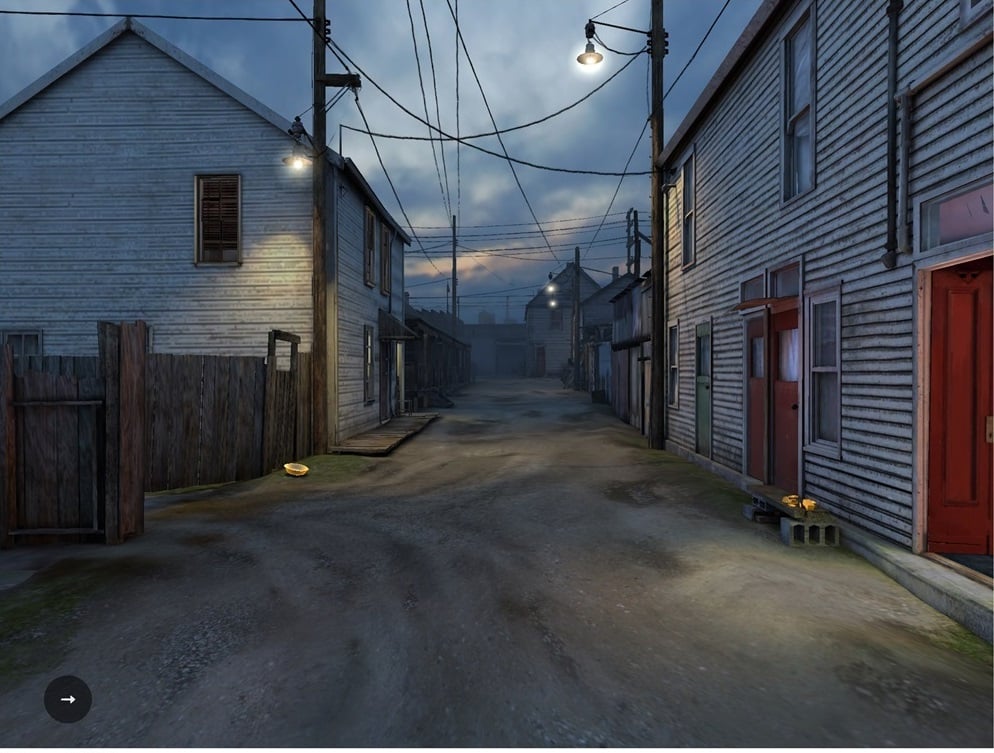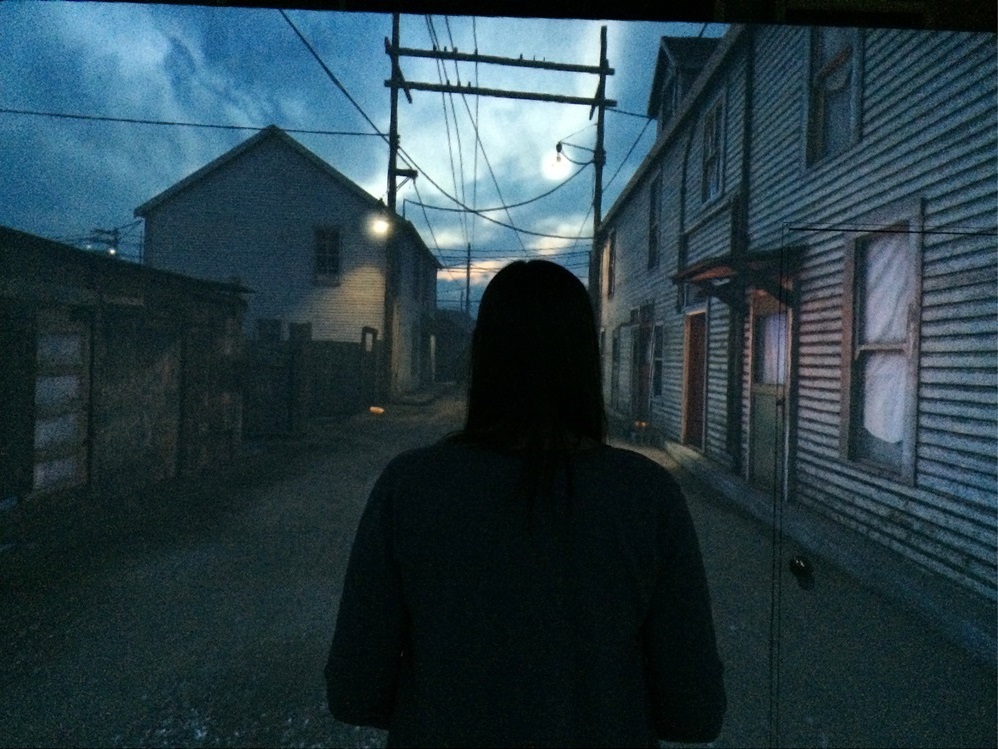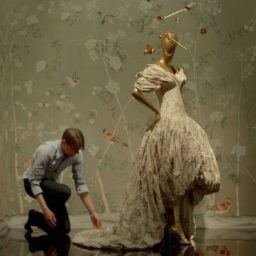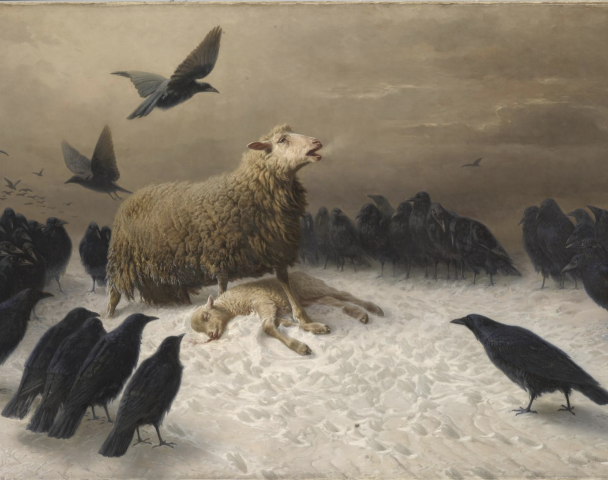


Hogan’s Alley, one of two gritty postwar Vancouver locales viewers can explore in Stan Douglas’s new project Circa 1948. Created by Stan Douglas and the NFB Digital Studio, produced by the National Film Board of Canada. Photo: taken from Production. Circa 1948 iPad app. © National Film Board of Canada
Five minutes flew by in what felt like the blink of an eye. I had stepped inside and then emerged from artist Stan Douglas’s immersive new installation, a virtual-reality–meets–video game project known as Circa 1948.
Circa 1948 debuted on April 22 at the Tribeca Film Festival (as part of the Bombay Sapphire House of Imagination project), and Douglas’s film, titled a “Storyworld” by the creators, was produced by the National Film Board of Canada (NFB).
The Circa 1948 installation is set in Vancouver in the years following World War Two. The viewer enters a shadowy film noir realm where the dark mood and gritty feel of the city in the late 1940s is conveyed by fragmented conversations between a vast array of characters: cops on the take; an angry man warning a would-be intruder to stay away from his house; a mysterious woman who has arrived in town in search of a man who once knew her murdered husband. There are no actual human figures in the piece, only ghostly shapes that glow intermittently as they speak and then fade as their voices diminish.
“You get glimpses, you can’t hear the whole story, only moments of that life story,” says Dana Dansereau, interactive producer for the NFB discussing the project at the festival. Three days after its debut, the waiting list to enter the installation for an allotted 5 minute slot was fully booked. “There is a tension between whether you stay put and listen to the stories. That is part of the inability to grab onto history. And the artist put that tension in there on purpose.”
Vancouver, where Douglas was born in 1960 and works and lives today, is portrayed in the project as a “rain-soaked city caught between the ruins of the an old order and the shape of things to come.” Though the scenes are rooted in the past, the connections between economic recession and a black market economy, as well as how the social dynamics of poverty and wealth play into urban planning will resonate with viewers.
Central to the project is a free interactive app downloadable on iTunes that offers viewers the opportunity to move through this dimly lit and vividly portrayed world. Swipe through screens, and touch on the glowing ghost-like figures or objects. This launches a conversation that lets the observer know what roles the respective characters are playing and what (usually troublesome) occurrence is happening in their lives at that moment.
For the app and the installation alike, viewers choose between two locales: Hogan’s Alley, where immigrant workers, drifters, and dreamers mix with corrupt politicians and cops; or the Hotel Vancouver, a once grand but now decaying hotel occupied mostly by grifters and homeless war veterans.

A user navigates through the Circa 1948 installation, using her body as the interface. Photo: Loc Dao © 2014 National Film Board of Canada
In order to move through the virtual reality installation, participants navigate a circle in the center of the room which lets them move through alleys, corridors, and rooms. My experience of gliding through the decrepit Vancouver hotel’s empty hallways and cavernous rooms, was vivid and surreal at once. (It was impossible not to think of Jack Nicholson’s character in the film The Shining drifting aimlessly through the empty Overlook hotel, engaging in hallucinatory conversations with polite but eerie wait staff while haunting piano and ballroom music wafted in the background.)
The free “Circa 1948” app is available on an ongoing basis at nfb.ca/circa1948, and contains 45 interactive stories to explore. Participation in the installation was limited to five minutes per person and by last Friday, the roster was booked solid. The NFB plans to bring the installation to other Canadian cities this fall.
The project also fueled a separate initiative for Douglas, a play called “Helen Lawrence,” inspired by the character in search of her murdered husband. The project comprises theater, visual art, live action–filming, and computer-generated simulations of historical Vancouver sites. It opened March 13 at the Stanley Industrial Alliance Stage in Vancouver, and will open the Festival TransAmerique in Montreal on May 22. Then it travels to Munich and Edinburgh before a run in Toronto at the Bluma Appel Theatre in Toronto in October.
Douglas, who shows with David Zwirner gallery in New York, is known for using films, photographs, and installations that reexamine particular locations or past events. In his most recent show at Zwirner’s 19th street space, Douglas presented Luanda-Kinshasa in which he showed a band of professional musicians jamming together in the 1970s. The event was staged in a reconstruction of the legendary Columbia 30th Street studio in Midtown Manhattan.







